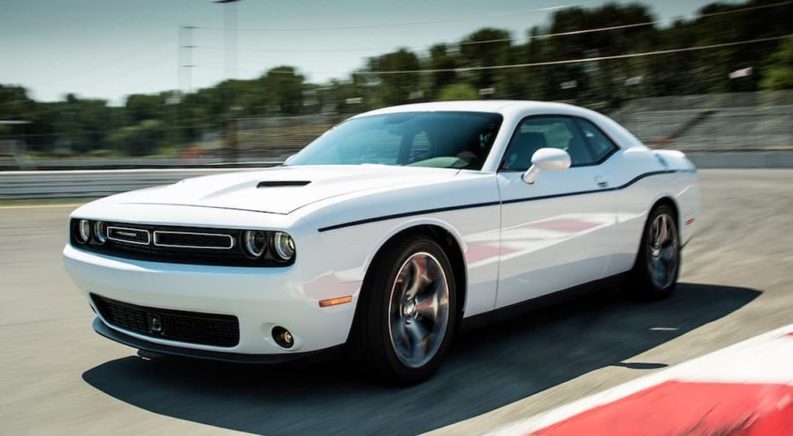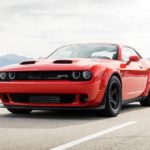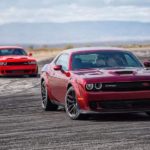To fans of American Muscle, an electrified version of this particular vein of vehicle may seem like an oxymoron. At a glance, electric vehicles (EVs) are a far cry from the big block V8s that spit out smog and ponies like they’re going out of style. The time is coming for EVs though, and Dodge’s announcement of having its first eMuscle car in the works is a testament to that. However, as powerful as they have the potential to be, an EV doesn’t match up to a good old-fashioned, gasoline-fueled muscle car in a lot of ways. They just don’t drive, feel, or sound the same. In the very near future, shopping for a Certified Pre-Owned Dodge may be the only option for those who crave the drive, feel, and sound of a V8 Challenger.
For any used high-performing vehicle, opting for a Certified Pre-Owned (CPO) model means that the car will be in tip-top shape and capable of handling the beating that only a true enthusiast can deliver. Throughout its many years on the market, the Challenger has come in many generations, trim levels, and special editions, meaning options for used Challengers will vary. However, there are a few versions of the Challenger that stand out from the pack and should be given consideration if you’re in the market.
1970-1971 Dodge Challenger R/T 426 Hemi
The first Dodge Challenger came right at as the sun was setting on American muscle, when the cars were bigger, the ponies were higher, and the powertrains were uninhibited by EPA regulations. The 1970 Dodge Challenger was available in several different body configurations and had a remarkably high number of engine offerings–seven, to be exact. The Challenger was built on the Chrysler E Body platform, which meant a sporty look, rear-wheel drive, and plenty of room under the hood for a brawny engine.
The legendary 1970 Dodge Challenger R/T was the performance model in the lineup, and the standard engine is an imposing 383-cubic inch (6.3-liter) V8 Magnum, which had 335 hp. The other options available were a 440-cubic inch (7.2-liter) V8 Magnum that gets 375 hp, a 440-cubic inch V8 Six-Pack rated at 390 hp, and the 425-cubic inch (7.0-liter) Hemi V8 that cranks out 425 hp. Despite issues with the original Dodge Challenger, like rampant rusting and an overly-flexible chassis, this generation holds a special place in the tender hearts of Dodge enthusiasts, even as the years roll by. EPA regulations meant necessary changes were made to the vehicle, beginning with the 1972 model year. The Hemi V8 was no longer an option, and the Dodge Challenger became a cleaner, albeit less powerful, vehicle.
2008 Dodge Challenger SRT8
After a long hiatus that started with the discontinuation of the Challenger in 1974 (unless you count Dodge’s rebadged version of the Mitsubishi Galant Lambda in the late ’70s and early ’80s, which I don’t), the muscle car was back with the 2008 Dodge Challenger SRT8. It debuted in a major way, only being offered in the top-level SRT8 edition that focused on performance. Fans of the retro Challenger couldn’t wait to see the legend reborn, and the Challenger SRT8 did not disappoint. It didn’t feel like a halfhearted stab at riding on a reputation, as is so often the case when a retired nameplate circulates back into production–I’m talking about any model name brought back only to be used for a crossover. No, the new Challenger looked the part with its hefty hood and retro body style. Its performance lived up to the name up as well, thanks to a 6.1-liter Hemi V8 that produces 425 hp and 420 lb-ft of torque. It gets up to 60 mph in a brisk 4.7 seconds. Like the original Dodge Challenger R/T, the Challenger SRT8 is RWD, although its only transmission is a 5-speed automatic.
2015 Dodge Challenger SRT Hellcat
In 2015, Dodge released the Challenger SRT Hellcat, an extra beefy version of the Challenger SRT. Under the hood, it packs a supercharged 6.2-liter Hemi V8, an engine derived from Dodge’s 6.4-liter Hemi V8, but with several components swapped out and more sophisticated cooling mechanisms. It’s also equipped with a 2.4-liter supercharger that can generate a maximum boost of 11.8 PSI. The power smokes that of classic Challengers at 707 hp and 650 lb-ft of torque. The Challenger Hellcat can accelerate to 60 mph in just 3.6 seconds. Numbers like these don’t turn up often in production cars, placing the Challenger Hellcat in a class of its own; other cars that could keep up at the time were a great deal more expensive and had names like “McLaren” or “Ferrari.” With great power comes great responsibility, so the Challenger Hellcat has two different keys. There’s a black fob, which limits the vehicle’s power to 500 hp, and a red fob that unleashes the full monstrosity of the engine’s capabilities.
2018 Dodge Challenger SRT Demon
In 2018, Dodge released a unique variant of their high-performing Challenger SRT: the Demon. The street-legal Challenger built for drag racing had a starting price in the ballpark of $86,000 at its debut. It’s not chump change, and CPO models aren’t much cheaper today, but the Challenger Demon can rip around a track like cars many times the cost. It’s powered by a supercharged 6.2-liter V8 that gets 808 hp with pump gas or 840 hp with 100-octane race fuel. When optimally fueled, the Demon will race from 0 to 60 mph in a dizzyingly quick 2.1 seconds. A vehicle with this kind of power potential requires a sophisticated cooling system, which is why the Demon has the largest hood scoop of any production vehicle, and headlights double as air intake ports. There’s also a built-in power chiller that utilizes the A/C to cool the engine, as well as a specific “Cool Down” mode that will drop the temperature quicker than if the car was just idling or turned off.
Aside from the breakneck speed and raw power, Challenger Demon owners gain loads of features unique to the vehicle. Flared-out fenders accommodate the tires created by Nitto Tires specifically for the Demon – they even have the Demon logo printed on the side. Drag slicks built to handle the power output of the Demon, these tires are technically street legal. However, there may or may not be a waiver involved wherein the owner agrees the special tires are not suitable for wet weather or highway driving. The vehicle features a front lip spoiler that won’t be found on any other factory Challenger and the vehicle’s mascot–a horned and bearded demon–can be found in various places inside the car and around the exterior.
What’s Next for the Challenger?
It hasn’t been announced whether Dodge’s new eMuscle car will be modeled after the Challenger or the Charger, but regardless of which vehicle gets electrified, the writing’s on the wall: the days of gasoline cars dominating the market are numbered. Be that as it may, the Challenger has spanned across decades and thrived, despite changing targets and regulations. Even more impressive is the Challenger’s uncompromising loyalty to its origins. In 2008, it brought American Muscle to the 21st century in a way that was more powerful–and cleaner–than its predecessor. One can only hope that an EV version of the Challenger would continue to redefine what power means without fully rewriting the script, but right now, you can still get your hands on a V8 Challenger, and there isn’t any time to wait.




